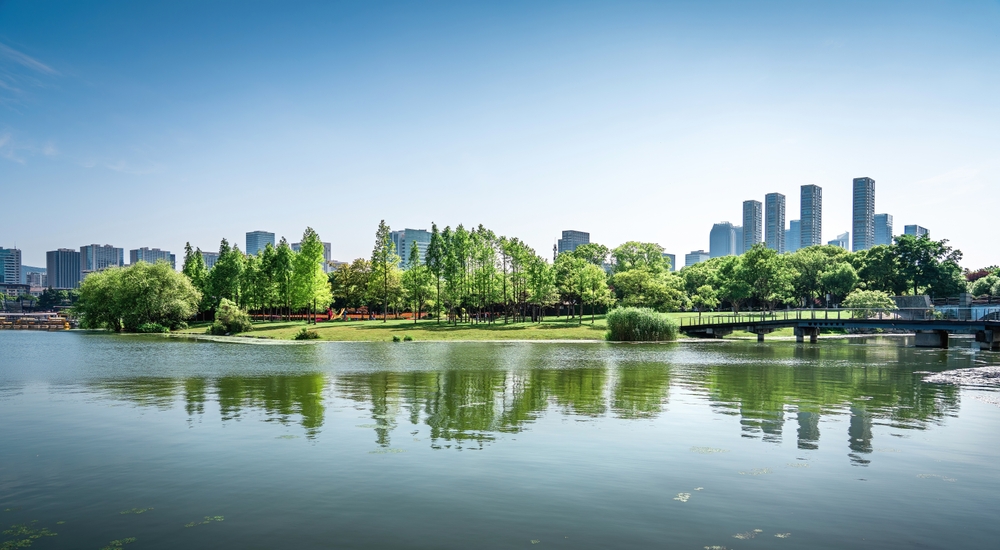
Today, more than half of the world’s population (about 4.4 billion people) lives in cities. By 2050, the United Nations projects that 68% of people will live in urban areas. Urban environments often share similar characteristics: extensive concrete, buildings, pavement, and pollution. Without green spaces, the health and well-being of individuals, communities, and surrounding ecosystems can suffer greatly. Increasing awareness and developing expertise in biophilic design are necessary to protect and expand these spaces.
What Is Urban Green Space?
Urban green spaces refer to areas within cities that are intentionally designed to include vegetation and are open to the public. Through this vegetation, these spaces provide ecological benefits to people, wildlife, and the surrounding environment. Around the world, many well-known examples illustrate the different ways cities embrace greenery.
In New York City, Central Park serves as a vast natural retreat amid skyscrapers, while Chicago’s Lincoln Park stretches along the lakefront with gardens, trails, and recreational areas. London is home to the historic Hyde Park, and Paris offers the elegant Parc Monceau as an oasis of calm.
Beyond traditional parks, innovative projects also showcase the versatility of urban green spaces. For example, Mexico City’s Foro Ciel Rooftop Garden brings vegetation to the top of a corporate building, and Liverpool’s St. John’s Shopping Centre features a striking Living Green Wall. Ultimately, these examples highlight how urban green spaces can take many forms, from sprawling parks to vertical gardens, all contributing to healthier, more livable cities.
Types of Urban Green Spaces
A city park is one of the most familiar examples of an urban green space, but it is far from the only type. These spaces come in many different forms, sizes, and configurations. Some are designed for recreation, such as outdoor play areas or green schoolyards, while others preserve natural landscapes like urban forests, wetlands, meadows, and heaths.
Greenways and nature preserves connect people to the outdoors on a larger scale, while public and residential gardens bring greenery into neighborhoods. In more built-up settings, innovative options such as rain gardens, rooftop gardens, and tree-lined streets extend nature into the urban fabric. Even places not always thought of as green spaces such as cemeteries can serve this role, offering residents both ecological benefits and a sense of calm.
Why Urban Green Spaces Are Important
Experts agree that too many people die each year from the effects of indoor and outdoor pollution, with estimates varying from about 3.8 million to 9 million. Beyond the loss of life, unhealthy environments can harm mental health, weaken community well-being, strain the economy, and damage surrounding ecosystems.
Urban green spaces help address these challenges while offering benefits for the environment, public health, the community, and the economy.
- Environment: Urban green spaces are essential to environmental health, offering multiple ecological benefits within cities. For instance, they help mitigate heat islands by providing shade and cooling surrounding air, while also improving air quality through the filtration and absorption of pollutants. At the same time, they support biodiversity by supplying habitats and resources for a variety of plant and animal species. Green spaces can also reduce noise pollution and aid in water management, making them a critical element in creating healthier, more resilient urban environments.
- Public Health: Urban green spaces play a crucial role in supporting community well-being. By reducing environmental hazards like air and water pollution and moderating extreme heat, they create safer and healthier surroundings. These spaces encourage physical activity through clean air and accessible outdoor environments, while also promoting mental health by lowering stress, boosting mood, and enhancing cognitive function. In some cities, green spaces even help mitigate food deserts by providing fresh produce.
- Community: Urban green spaces contribute to healthier, safer, and more connected communities. They provide accessible areas for social interaction, group recreation, and community engagement, fostering a sense of belonging while helping to reduce loneliness and isolation. Through the promotion of mental wellness and encouraging positive social interaction, these spaces can help reduce crime rates. Additionally, they enhance physical and mental health, strengthen community bonds, and add beauty to the urban landscape — making cities more pleasant and welcoming places to live.
- Economics: Urban green spaces also play an important role in supporting economic prosperity. For instance, they can increase the value of nearby properties and attract visitors through unique experiences and recreational opportunities that boost tourism. These spaces further sustain local businesses and stimulate broader economic activity. In addition, encouraging physical activity and healthier lifestyles helps lower healthcare costs for individuals, extending the benefits of green spaces well beyond their immediate surroundings.
Urban Green Space and Climate Resilience
Urban green spaces provide a wide range of environmental benefits that help cities move toward greater sustainability and address the effects of climate change. By offering shade, reducing surface temperatures, and regulating water vapor, they play an important role in moderating urban heat. These spaces also support water management by helping to replenish city aquifers, while simultaneously mitigating the impact of weather extremes by absorbing stormwater and reducing flooding.
Beyond these functions, green areas strengthen ecological networks by offering habitats and resources for wildlife and pollinators. They even contribute to carbon sequestration, absorbing CO₂ and storing carbon to help offset emissions. Together, these benefits make urban green spaces an essential tool for building healthier, more resilient cities.
Examples of Successful Urban Green Space Initiatives
Recognizing the power, potential, and importance of urban green spaces, many cities have successfully implemented initiatives to promote and facilitate their development and expansion. Some examples of promising green space initiatives include:
- The High Line in New York City, NY – This innovative green space takes a uniquely linear form. Stretching for almost one and a half miles, the High Line park is built atop a former railway line on the West Side of Manhattan. In addition to art installations, the park offers an abundance of trees and plants.
- Millennium Park in Chicago, IL – Encompassing 24.5 acres of Grant Park, Millennium Park officially opened in 2004 after several years of planning and construction. While the project far exceeded its budget, it was ultimately deemed successful. It draws in visitors and supports locals with a variety of features, such as the 2.5-acre Lurie Garden, a loop trail, and the world’s largest rooftop garden.
- The Cheonggyecheon Stream Restoration in Seoul, South Korea – During the rapid industrialization of South Korea and the growth of its capital city, Seoul, the Cheonggyecheon Stream was covered by an elevated highway and other concrete structures. The restoration project, which began in 2003, aimed to remove the viaducts and highway covering the stream, restore its banks, and create an urban green space to renew and revitalize the downtown area.
- Singapore Green Plan 2030 in Singapore – An ongoing national movement, the Singapore Green Plan has set a group of nationwide targets and initiatives to improve the city-state’s environmental health by expanding green spaces, promoting sustainable living, and focusing on cleaner energy. The plan aims to plant one million trees, enhance more than 420 acres of existing parks, develop more than 300 acres of new parks, increase the land area of nature parks by 50%, and ensure every household is only a 10-minute walk from green space.
- The Green Bay Watershed in Green Bay, WI – The Northeast Wisconsin Land Trust supports the Oconto Preserve and the protection and preservation of one of the largest freshwater estuaries in the world. The Green Bay watershed spans 10.6 million acres and supports more than a third of the water flowing into Lake Michigan.
Learn How to Support Healthier Environments at Unity Environmental University
The existence and creation of urban green spaces, especially in cities where they are limited, is vital to the health and well-being of people, communities, and the environment. These spaces promote better mental and physical health and help reduce the effects of climate change, making cities safer and healthier.
By pursuing a Bachelor of Science in Applied Psychology and Biophilic Design at Unity Environmental University, students can explore the impact of spaces and environments on the human body and mind while discovering how to optimize sustainable structures and designs for a healthier, happier human experience.



